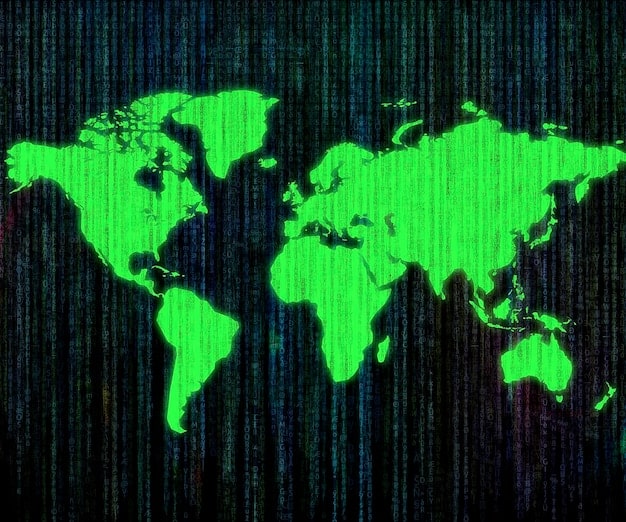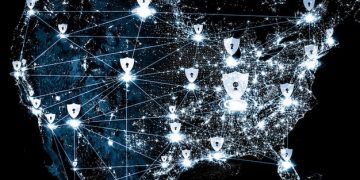Cybersecurity Threats 2025: Protecting US Infrastructure

Cybersecurity threats in 2025 are projected to escalate, posing significant risks to US infrastructure through sophisticated ransomware attacks, IoT vulnerabilities, and state-sponsored espionage.
The digital landscape is constantly evolving, and with it, the sophistication of cyberattacks. As we look ahead to 2025, understanding the emerging **cybersecurity threats in 2025: protecting US infrastructure from future attacks** becomes paramount to safeguarding critical systems and data.
Understanding the Evolving Threat Landscape
The threat landscape is constantly shifting, demanding constant vigilance and adaptation. By 2025, we can anticipate a surge in sophisticated cyberattacks targeting critical infrastructure.
Several factors contribute to this evolution, including the increased reliance on interconnected systems and the growing sophistication of threat actors.
The Rise of Ransomware 2.0
Ransomware attacks are evolving, becoming more targeted and disruptive. We can expect to see “Ransomware 2.0” in 2025.
This advanced form will leverage AI to identify high-value targets and automate the attack process while employing new extortion tactics such as double extortion.

- AI-powered targeting: Identifying vulnerable systems with high potential payouts.
- Automated attack execution: Streamlining the ransomware deployment process.
- Double extortion tactics: Data exfiltration combined with encryption.
These tactics will increase the pressure on victims to pay the ransom, as they face not only operational disruption but also the risk of sensitive data being leaked.
In conclusion, understanding the rapidly evolving threat landscape is crucial for effective cybersecurity strategies. The challenges posed by sophisticated ransomware, IoT vulnerabilities, and nation-state actors demand a proactive and adaptive approach to protect US infrastructure.
IoT Devices as Entry Points
The proliferation of IoT devices introduces an expanded attack surface. By 2025, the vulnerability of these devices will become a major concern.
Many IoT devices lack robust security measures, making them easy targets for exploitation. Furthermore, the sheer volume of these devices makes it difficult to manage and secure them all.
Weak Security Protocols
Many IoT devices are designed with weak security protocols. The limited processing power can hinder the implementation of advanced security measures.
This makes them vulnerable to attacks that could be easily prevented with stronger encryption or authentication methods.
Botnet Amplification
Compromised IoT devices can be used to launch large-scale DDoS attacks. These botnets can overwhelm network infrastructure, causing widespread disruption.
- Distributed Denial-of-Service (DDoS) attacks: Overloading networks with traffic.
- Data breaches: Exfiltration of sensitive information from connected devices.
- Lateral movement: Using compromised devices to access other network resources.
Securing IoT devices will require a multi-pronged approach, including stronger security standards, regular software updates, and network segmentation.
In brief, the integration of IoT devices into critical infrastructure presents a double-edged sword, enhancing connectivity and efficiency while simultaneously expanding the attack surface. Addressing these vulnerabilities requires a holistic and proactive approach to cybersecurity in the future.
Nation-State Cyber Warfare
Nation-state actors pose a significant threat to US infrastructure. Driven by geopolitical objectives, these actors possess advanced capabilities and resources.
Furthermore, nation-state cyber warfare is increasingly targeting critical infrastructure to disrupt operations, steal sensitive data, and gain strategic advantages.

Espionage and Sabotage
Nation-state actors are engaged in espionage to gather intelligence on US infrastructure. Their goals can range from stealing intellectual property to disrupting critical services.
Cyber espionage operations often involve the use of advanced persistent threats (APTs) to maintain long-term access to target systems.
Targeting Critical Infrastructure
Attacks can disrupt essential services such as power, water, and communication networks. These attacks can have devastating consequences, affecting millions of people.
- Power grid disruptions: Causing widespread blackouts and economic damage.
- Water supply contamination: Affecting public health and safety.
- Communication network outages: Disrupting essential services and emergency response efforts.
Combating these threats requires robust defenses and international cooperation to deter and respond to malicious cyber activities.
In summary, as we move closer to 2025, the specter of nation-state cyber warfare looms large, necessitating a multi-layered defense strategy that combines advanced technology, proactive threat intelligence, and robust international collaboration.
The Role of Artificial Intelligence in Cybersecurity
AI can be a powerful tool for both attack and defense. By 2025, AI will play an increasingly important role in cybersecurity.
AI can be used to automate threat detection, analyze large volumes of data, and respond to incidents more quickly. However, it can also be used by attackers to launch more sophisticated attacks.
AI-Powered Threat Detection
AI can analyze network traffic and identify anomalous behavior. This can help detect attacks that would otherwise go unnoticed.
AI algorithms can learn from historical data and adapt to new threats, making them more effective than traditional rule-based systems.
AI-Driven Attacks
AI can automate many aspects of cyberattacks. Phishing campaigns are highly personalized to trick victims into divulging sensitive information.
- Automated phishing campaigns: Creating convincing and personalized phishing emails.
- Evasion techniques: Bypassing security defenses with AI-powered techniques.
- Malware development: Generating new and polymorphic malware variants.
Therefore, staying ahead of AI-driven attacks will require a proactive approach to cybersecurity, including ongoing research and development of AI-powered defense mechanisms.
In conclusion, the integration of artificial intelligence into cybersecurity in 2025 represents a paradigm shift that demands a proactive and adaptive approach to ensure resilience and effectiveness in the face of evolving cyber threats.
Investing in Cybersecurity Infrastructure
Protection requires substantial investment in cybersecurity infrastructure. Governments and organizations must prioritize allocating resources to strengthen their defenses.
Investment should focus on key areas such as threat intelligence, incident response, and employee training to ensure a comprehensive approach.
Upgrading Legacy Systems
Many organizations rely on outdated systems that are vulnerable to attacks. Upgrading legacy systems is essential to improve security.
These steps include patching vulnerabilities, implementing modern authentication methods, and migrating to more secure platforms.
Developing a Cybersecurity Workforce
There is a shortage of skilled cybersecurity professionals. Investing in education and training programs is crucial.
- Cybersecurity training programs: Equipping employees with the knowledge and skills to identify and respond to threats.
- Industry certifications: Validating the expertise of cybersecurity professionals.
- Public-private partnerships: Collaborating on cybersecurity initiatives and sharing best practices.
Investing in cybersecurity infrastructure and workforce will strengthen the nation’s ability to withstand attacks and protect its critical assets.
In summary, investing in cybersecurity infrastructure is not merely an option but a critical imperative for protecting US infrastructure from future attacks, safeguarding national security, and ensuring economic stability.
Legislative and Regulatory Frameworks
Strong legislative and regulatory frameworks are needed to address cybersecurity risks. Government regulations can help establish minimum security standards and promote best practices.
These frameworks should be flexible enough to adapt to the evolving threat landscape while providing clear guidance to organizations.
Enhancing Data Protection Laws
Data protection laws such as GDPR are a step in the right direction. These can help ensure that organizations protect sensitive data and comply with security standards.
They also provide individuals with greater control over their personal data, including the right to access, correct, and delete their information.
Promoting Information Sharing
Effective information sharing is essential for detecting and responding to attacks. Threat information is shared among government agencies, private sector organizations, and international partners.
- Cybersecurity Information Sharing Act (CISA): Promoting the voluntary sharing of cyber threat information.
- Information sharing platforms: Facilitating real-time collaboration and information exchange.
- Incentives for sharing: Encouraging organizations to share threat information by providing legal protections and other benefits.
These frameworks can help protect critical infrastructure and promote cybersecurity in the US.
In brief, legislative and regulatory frameworks play a pivotal role in shaping a secure digital ecosystem by establishing clear guidelines, promoting accountability, and fostering collaboration among stakeholders.
| Key Point | Brief Description |
|---|---|
| 🚨 Ransomware 2.0 | AI-driven, targeted attacks with new extortion tactics. |
| 🛡️ IoT Vulnerabilities | Weak security protocols in IoT devices lead to botnet amplification. |
| 🌐 Nation-State Cyber Warfare | Espionage and sabotage targeting critical US infrastructure. |
| 🤖 AI in Cybersecurity | AI-powered threat detection alongside AI-driven attacks. |
FAQ
▼
The biggest threats include advanced ransomware attacks, exploitation of IoT vulnerabilities, and nation-state cyber warfare targeting critical infrastructure. These risks require proactive and adaptive security measures.
▼
AI can enhance threat detection by analyzing network traffic and identifying anomalies. It can also automate incident response and adapt to new threats, improving overall security posture.
▼
Securing IoT devices involves implementing stronger security standards, providing timely software updates, and segmenting networks. This ensures that vulnerabilities are minimized and contained, improving overall security.
▼
Governments can establish legislative frameworks, enforce data protection laws, and promote information sharing, fostering a secure environment that complies with regulation standards.
▼
Investing boosts overall security to handle any potential incidents or threats. Investments ensure that infrastructure can adapt to new cyber threats with proactive responses.
Conclusion
Protecting US infrastructure from cybersecurity threats in 2025: protecting US infrastructure from future attacks demands a comprehensive and proactive approach. By understanding and addressing these challenges, we can enhance our cyber defenses. This proactive investment ensures the safety and resilience of critical systems.





